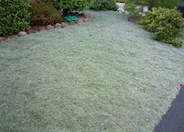
Common name:Dymondia, Rock Ditty
Botanical name:Dymondia margaretae
This foliage is gray/green/silvery; it is a very dense, mat forming ground cover. It tolerates drought, cold, salt spray and poor soils. It's deep rooted and produces small, inconspicuous yellow flowers. Rock Ditty is great for use in between stepping stones or pavers.

Common name:Kleinia
Botanical name:Senecio mandraliscae
This succulent perennial will grow to about 1.5' tall and 2' wide. It has curved, bluish gray leaves that are about 3.5" long and very slender.
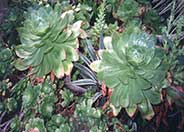
Common name:Aeonium Succulents
Botanical name:Aeonium species
These plants are one of the most useful succulents, due to their decorative effects and sculpturesque quality. The branched stems hold a wide rosetta of either light green or purple leaves. The flowers appear in long, clustered form. They need some shade in hotter areas. Prostrate forms are low-growing, and spreading.
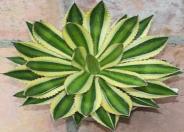
Common name:Quadricolor Century Plant
Botanical name:Agave lophantha 'Quadricolor'
This Texas native is found on gravelly limestone and rocky areas. Leaves are an open rosette form, fairly flat and sword-shaped, green in color with spines along the margins. This plant reaches 2' tall and 3' wide. Occasionally, this plant sends up a tall spike 12' tall with greenish yellow flowers. This marks the death of the plant but there are usually offspring close by. Plant in full to part sun with well draining soil. It is drought tolerant once it's established.
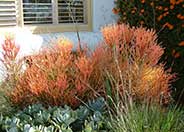
Common name:Sticks on Fire Pencil Tree
Botanical name:Euphorbia tirucalli 'Sticks on Fire'
In frost free areas, Euphorbia can become a 30' tree but in colder areas, it is often knocked back by frost. It can be single or multiple trunked. It has green cylindrical branches that are about the diameter of a pencil. Leaves are not usually present. Some people are allergic to the sap. It is tolerant of salt, full sun, part shade and quite drought resistant. It is a great accent plant for a container. This form has yellow or orange branches if in full sun.
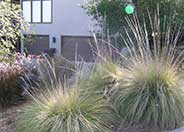
Common name:Deer Grass
Botanical name:Muhlenbergia rigens
The Deer Grass is a warm season perennial that forms dense clumps from the base. The spike-like flower stalks grow 2'-3' tall and this grass has striking foundation form. The Deer Grass is native to California and needs watering once or twice a month after it has been established. The more water it has, the greener it is.
Designer: Diane Conejo
Photographer: GardenSoft
Physical weed control, including mulching, or hand removal protects the watershed from harmful chemicals.
Check the soil's moisture level before watering.
You can reduce your water use 20-50% by regularly checking the soil before watering.
Develop healthy soil for plants that are vigorous and naturally pest-resistant.